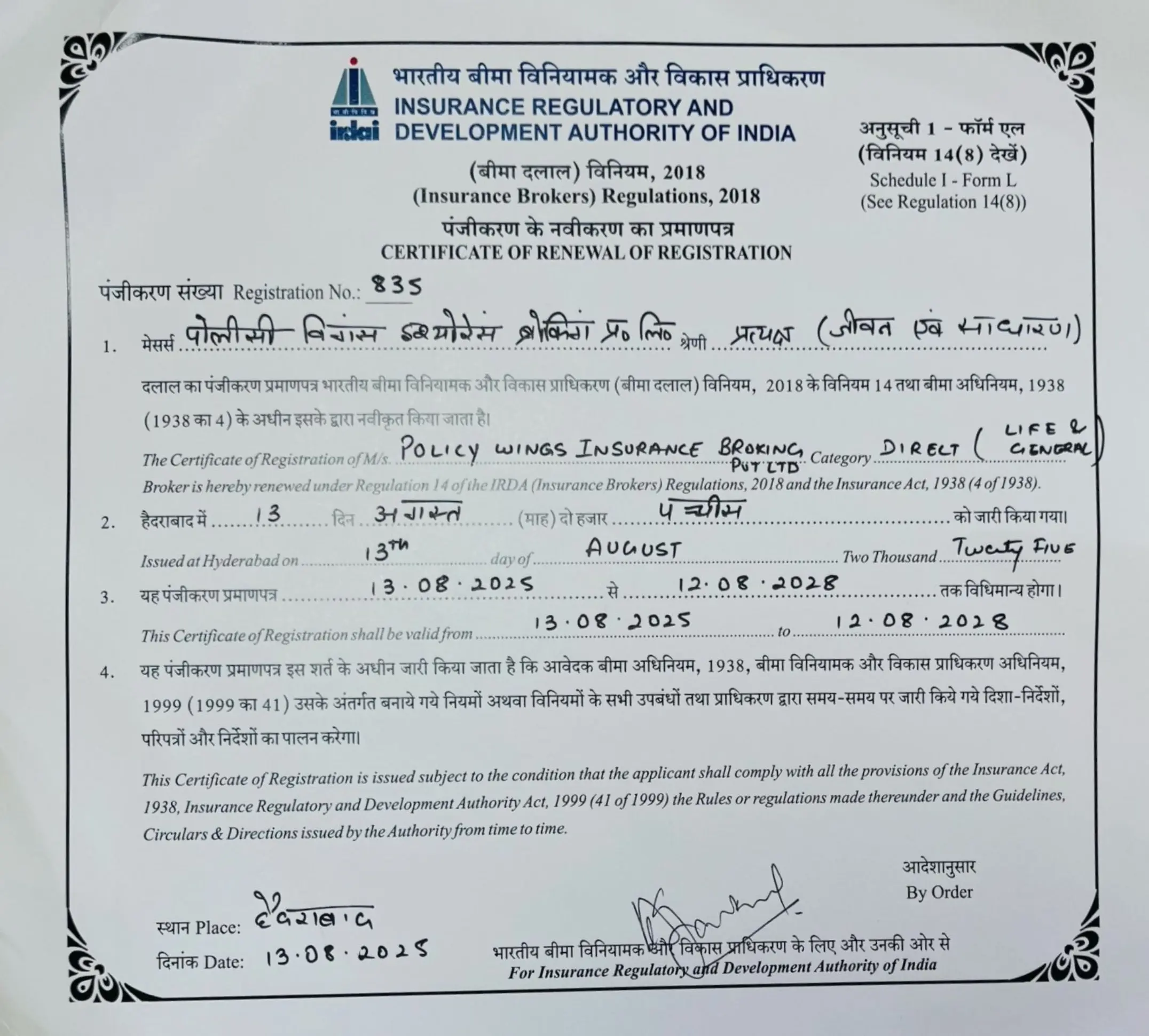Travel Insurance
Travel Insurance for Family with Policywings
Travel insurance for family is a must for safe and stress-free trips. Even risks can emerge in domestic travels, like medical emergencies, accidents, flight delays, or lost baggage that could significantly disrupt your plans and budget at the same time. Policywings offers simple as well as affordable plans, so that you can protect your entire family under one policy. You can enjoy your vacation knowing you’re covered against unexpected expenses. Travel smart, travel insured.
No matter if it’s a short weekend getaway or an entered holiday, when you go with travel insurance, it ensures peace of mind. Plus, it offers access to emergency assistance, cashless hospitalisation, as well as support services. You can secure each and every journey, making unforgettable memories without worrying about what-ifs.
Travel Insurance for Family: What is it and Why do You Need it?
1.Peace of Mind :
Travel Insurance for family refers to a policy that provides financial protection against unexpected events and mishaps during your travels. It covers a wide range of risks, including medical emergencies, trip cancellations, lost baggage, and more. But why exactly do you need travel insurance?
2.Medical Emergencies :
Illnesses and accidents can happen anywhere, even during your travels. Quality travel insurance ensures that you receive the necessary medical care without worrying about the expenses, especially if you’re traveling to a country with high healthcare costs.
3.Trip Cancellations and Interruptions :
Imagine saving up for a dream vacation only to have it canceled or cut short due to unforeseen events like natural disasters, illness, or other emergencies. Travel insurance can reimburse you for non-refundable expenses and help you reschedule or return home safely.
4.Lost or Delayed Baggage :
Misplaced or delayed baggage can be a hassle during your trip. Travel insurance can provide coverage for lost belongings, allowing you to replace essential items and continue enjoying your journey stress-free.
5.Personal Liability :
In unfortunate situations where you accidentally cause damage or injury to others, travel insurance can offer protection against legal expenses and liability claims.
6.Financial Protection :
Travel expenses can add up quickly, and unexpected events can lead to significant financial losses. Having travel insurance for family safeguards your investment by reimbursing non-refundable costs in case of cancellations, delays, or other covered incidents.
Types of Travel Insurance Policies
Travel insurance policies come in various forms, tailored to meet different travel needs. Let’s explore some common types:

This type of insurance reimburses you for prepaid and non-refundable expenses if you need to cancel your trip due to covered reasons, such as illness, injury, or a death in the family. It provides financial protection for flights, accommodations, and other prepaid costs.

Medical insurance covers the costs associated with unexpected illnesses, accidents, or medical emergencies that occur during your travels. It includes coverage for hospital stays, emergency medical care, doctor’s visits, medications, and sometimes even medical evacuation.

Baggage insurance protects against lost, stolen, or damaged baggage. It provides coverage for personal belongings, such as clothing, electronics, and other essential items. Some policies may also include compensation for delayed baggage.

Evacuation insurance covers the expenses of emergency medical evacuations, especially in remote areas where adequate medical facilities are unavailable. It ensures that you receive proper medical care and transportation to a suitable medical facility.
How to Choose the Right Travel Insurance for Family Policy
Selecting the right travel insurance policy requires careful consideration of your needs and preferences. Here are some factors to keep in mind when making your decision:
- Coverage : Review the coverage limits of different policies to ensure they meet your specific requirements. Consider the maximum coverage for medical expenses, trip cancellations, baggage losses, and other relevant aspects
- Exclusions and Limitations : Thoroughly read the policy documents to understand what is not covered and any limitations that may affect your claim eligibility. Common exclusions may include pre-existing medical conditions, extreme sports activities, or acts of war.
- Deductibles and Premiums : Evaluate the deductibles and premiums associated with each policy. A deductible is the amount you must pay before the insurance coverage kicks in, while premiums are the regular payments you make for the policy. Strike a balance between affordability and adequate coverage
- International Coverage : If you’re traveling internationally, ensure that the policy provides coverage in your desired destination. Check if there are any restrictions or limitations for specific countries.
- Additional Benefits : Consider any additional benefits or value-added services offered by the insurance provider, such as 24/7 emergency assistance, concierge services, or coverage for adventure activities.
- Provider Reputation and Customer Reviews : Whenever you consider having a travel insurance for family try to get insight on reputation and review. Research the insurance provider’s reputation and read customer reviews to gauge their reliability, customer service quality, and claims handling process. Choose a reputable provider with positive feedback from policyholders.
Latest Blogs
Introduction Buying car insurance is no longer just about ticking the “third party” box. Many owners today evaluate addons such as bumper to bumper (commonly called “zero depreciation”) to reduce out of pocket repair costs. But what happens once your car crosses the 5 year mark? This article explains zero depreciation insurance eligibility in India, what IRDAI endorsed wordings say and whether bumper to bumper insurance after 5 years is a smart buy, specifically for Policywings readers who want clear, practical guidance. What “bumper to bumper”/zero depreciation actually covers Bumper to bumper and zero depreciation addons are designed to eliminate the depreciation deduction applied during claim settlement for replaced parts, especially plastic, rubber and fibre components that wear out fast. In plain terms: if you have the add-on and your claim is admissible, the insurer pays the part replacement cost without deducting the normal depreciation. This improves claim value but increases your premium at renewal. Age limits and regulatory wording you should know There is no single nationwide rule that every insurer follows; eligibility depends on insurer product rules and the specific addon wording. However, many major insurers cap zero depreciation eligibility to the earlier years of the car’s life (typically up to 5 years). At the same time, IRDAI endorsed endorsement wordings used by public insurers sometimes specify different age slabs for example, a nil depreciation endorsement used by Oriental Insurance states cover is available for vehicles whose age is less than or equal to 6.5 years on policy inception and limits certain claims to the first two partial loss claims in a policy year. That demonstrates insurer discretion and differing product design. Is bumper to bumper available after 5 years in India? Short answer: sometimes. Most insurers stop offering traditional zero depreciation addons once a car is older than 5 years, but some insurers extend similar covers to older vehicles with conditions (higher premium, limited claim count or capped parts). A few market players advertise options up to 7 or even 10 years for “bumper to bumper” type covers, but those products are rarer and usually more expensive. Always confirm the exact eligibility at renewal, because availability varies by insurer and by the addon wording. Recent regulatory or compliance notes (what changed and what matters) IRDAI continues to standardize endorsements and expects insurers to disclose addon limits, age slabs and exclusions clearly at the point of sale and renewal. The Oriental Insurance nil depreciation endorsement is an example of a standardized wording that spells out age calculation, claim limits and exclusions, a useful template that other insurers echo. Also remember third party liability insurance remains legally mandatory under the Motor Vehicles Act; addons are voluntary enhancements to your comprehensive cover, not substitutes for statutory protection. Practical checklist: should you buy bumper to bumper after 5 years? Consider your car’s IDV (insured declared value). If the IDV is already low, a higher premium for zero dep may not give proportional benefit. Evaluate typical claim cost. If most past claims on your model involve plastic/fibre parts (bumper, headlights, trims), zero dep can save materially. Check limits: some policies restrict zero dep to the first one or two partial loss claims per year, read the renew offer carefully. Compare alternative addons: glass cover, engine protection and consumables cover may be cheaper and address the exact exposures you face. Factor in No Claim Bonus (NCB) and deductibles, a frequent small claim could erode NCB benefits and make the addon less attractive. When it’s usually worth it Bumper to bumper is cost effective when: the car is driven in high risk environments (city traffic, rough roads), replacement parts for your model are expensive and you value cashflow certainty for repairs. For cars with higher cosmetic replacement costs (modern plastic bumper assemblies, advanced headlamp units), the addon often pays back quickly in a single mid sized claim. When to skip it If your vehicle’s IDV is low, you drive sparingly, repairs are usually minor or your budget prioritises keeping premiums down, skip the addon or look for targeted covers (glass/engine/consumables) instead. After 5 years, many owners find targeted riders offer a better premium to benefit ratio. How to shop at renewal Ask insurers explicitly about “bumper to bumper insurance after 5 years India” options and get the precise endorsement wording. Compare at least 3 proposals for premium, claim limits and exclusions. Confirm whether mid term inclusion is allowed (many endorsements prohibit mid term additions). Keep record of prior claims and NCB, they affect pricing. Conclusion Bumper to bumper (zero depreciation) after 5 years can be available but is not universally offered; when it is, it often comes with stricter terms and higher cost. The decision should be pragmatic: weigh IDV, typical repair costs for your car model, claim frequency and the exact addon wording at renewal. For many 5+ year cars, targeted addons deliver more value than a blanket zero dep but if you drive in risky conditions and parts are costly, a carefully chosen bumper to bumper option may still be worth the premium. Always read the endorsement wording before you buy.
...Introduction Mergers & Acquisitions Insurance in India also known as transactional risk insurance has evolved as an important tool for deal makers to evaluate and decrease risk in complicated M&A transactions. What is M&A Insurance(Transaction Risk Insurance) M&A insurance (Transaction risk insurance) refers to the policies that protect parties in a merger or acquisition from losses arising from certain transaction risks. These include breaches of representations & warranties (R&W), undisclosed liabilities (e.g. tax liabilities), environmental or regulatory risks or other post closing liabilities. Parties use insurance to shift certain risks to insurers, reducing exposure, improving certainty and often facilitating effortless deal closure which is way better than only relying on contractual indemnities. More Usage of M&A Insurance in India Speed and planning: Caps and escrow can be simplified because insurance can replace or support seller indemnities and claim negotiations. More competitive insurance market: Premiums are now more competitive. Insurers provide broader coverage which makes it possible for smaller deals with lower enterprise value to get insured. M&A Insurance: Legal & Regulatory Structure Insurance Regulatory & Development Authority of India (IRDAI): The regulator for insurance business. Any transactional risk insurance policy will be under its supervision. Insurance Act 1938 and IRDAI Act 1999: The Insurance Act manages insurance contracts. The IRDAI Act controls regulation of insurers including registration, solvency, conduct of business, disclosures, etc. Proposed Insurance Laws (Amendment) Bill 2024: In 2024, the Indian government has proposed extensive amendments to the Insurance Act and IRDAI Act. These may influence rules for registration, operational matters and risk allocation regulations. Parties using M&A insurance should look out for these developments. Company Law, Securities Law & FDI Regulations: M&A usually involves regulated sectors, foreign investment, securities rules (example for listed companies), disclosure obligations and antitrust/competition law (example CCI approval). This establishes what risks are insurable, what exposures must be disclosed and the drafting of R&W. Recent Changes & Compliance Trends India’s regulatory and legal environment has seen changes that affect how transaction risk insurance is used, structured and enforced: Use of ‘buy side’ policies is more common: In general, the seller side has warranty/indemnity risk. Increasingly, buyers are getting insurance to cover their post closing claims if the seller fails to perform. Following international rules: Indian companies and insurers are changing policy wordings, jurisdiction rules and coverage to reflect global standards as international transactions are rapidly rising. Law firms and brokers also play an important part in customising these policies. Litigation and regulator: Regulators like IRDAI, tax, environmental and data protection authorities are paying closer attention. Hidden or undisclosed liabilities like tax or environmental issues have caused recent claims and this makes compliance and full disclosure very important. M&A Insurance Policies Structure Parties should consider these following points to manage transaction risks effectively using M&A insurance: Scope of coverage: What representations & warranties are insured, which liabilities are excluded (example known risks, fraud or certain regulatory risks). Negotiating timelines for disclosure. Retention/deductible: How much amount of risk remains with the seller or buyer affects premium and enforceability. Policy limits & claims period: How long after closing can claims be made (it’s usually between 2 to 4 years) or What is the maximum amount of money that can be lost. Tail or run off coverage: After the deal for the seller side, there could be liabilities that can come up later and buyers may require sellers to maintain certain insurance or give indemnity for a period or insurance companies might offer tail coverage. Change in control clauses: Many policies include clauses that modify coverage if the corporate structure changes significantly (postmerger) or after acquisition to prevent coverage gaps. Disclosure and due diligence: The quality of due diligence directly influences risk perception. Misstatements or omissions can result in claim denials. Comprehensive information exposure helps minimise insurer objections. Recent or Emerging Legal Risks & Must Knows Tax liability & DTAA clauses: With international transactions, tax treaties (Double Taxation Avoidance Agreements) and local Indian tax regulations pose potential undetected liabilities. Insurers may require enhanced disclosure. Data Privacy / Cybersecurity Laws: Upcoming laws in India (like Data Protection Bill, etc.) maximise liability exposure for companies and insurers are increasingly enquiring about compliance with such laws. Failure in this area may result in uncovered losses. Benefits vs Challenges Benefits: Decreases post closing risk for buyer and seller. Facilitates in faster closings when contractual risk problems are insured. Increases credibility with external investors or lenders. Challenges: Cost of premiums (particularly for complicated or high risk sectors). Time and negotiation required to agree on policy wording, procedure of disclosures. Insurers may deny covers for specific known but not fully disclosed risks. Possible overlap, dispute or conflict with other insurance, indemnities or warranties. Conclusion M&A insurance (transactional risk insurance) has become a foundation of India’s transaction framework. Buyers and sellers negotiate with greater confidence, shorten timelines and unlock transactions by transferring critical risks to insurers which otherwise might delay or obstruct operations. To increase its value, dealmakers have to stay alert for regulations developments, structure policies carefully and coordinate insurance coverage with industry regulations.
...Introduction India is famous for its impressive celebrations and weddings especially hold traditional, cultural and financial importance which is incomparable in the world. From destination weddings to grand corporate events the expenses involved mostly go up to lakhs or crores of rupees even. As it has such a large scale, any interruption like unforeseen weather, vendor disagreements or immediate emergencies can result in big financial losses. And this is why wedding insurance in India and event insurance cover are growing attention nowadays. Conventionally, insurance in India has focused on life, health, motor and property. But as regular daily life evolves and expenses on social functions escalate, event insurance is materialising as a new protection. It shows financial wisdom and a change toward planned risk management in personal as well as corporate life. Growing Popularity of Event Insurance In 2025, the need for event insurance cover has increased considerably. Weddings, concerts, exhibitions and even religious functions are now being insured to secure organisers and hosts from unpredicted interruptions. Especially for weddings where strategies mostly start months before or years in advance, insurance is a way to protect expenditures of a family’s life. The numerous destination weddings all over India and abroad have rapidly increased the trend. With huge costs invested in venue bookings, travel arrangements, catering and other plannings, families are increasingly reluctant to leave any matter to chance. Insurers have acknowledged by offering comprehensive packages specifically customised for marriage insurance with broader event insurance policies. What Wedding Insurance Covers? 1. Wedding insurance generally covers a broad type of risks. The most common are cancellation or postponement of the wedding because of the uncontrollable circumstances like extreme weather, accidents or sudden illness in the family. Policies also cover vendor related problems like caterers or photographers lacking to deliver services as well as the loss of deposits for venues or decorations. Event insurance mostly includes coverage for damage to property also including expensive decorations, sound systems and lighting equipment. Damage, theft or loss of valuable items like jewelry may also be included but it depends on the policy. Few advanced policies even give liability cover which protects the hosts if a guest sustains an injury or damage during the event. For big scale corporate or cultural events, the capacity expands further. Coverage may include cancellation because of the government restrictions, public unrest or technical failures which prevent the event from proceeding as planned. This makes event insurance an extravagant safeguard for both businesses and families. Why is Event Insurance Becoming Essential? The rapid acquisition of event insurance cover is about financial protection and peace of mind as well. Weddings and large events include multiple vendors, contracts and moving parts which increase the risk of something going wrong. And weddings can be an emotional and social highlight, so, the financial and reputational poles are high. Insurance makes sure that years of hardwork, savings or borrowed funds are not gone to waste because of the unforeseen disruptions for families. For corporate event organisers, insurance decreases financial disclosure and helps maintain credibility with clients. In both cases, the coverage lets the hosts focus on the event rather than getting tense about potential mishaps. Trends Shaping Wedding & Event Insurance 1. Increasing demand for customisable policies: Families and organisers do not want basic protection but prefer to customise policies to the scale and nature of their event. The evolution of technology: Many insurers now permit online purchases and claim processing which makes it quite simple for families and businesses to get coverage fastly. Digital platforms also enable real time tracking of claims which builds transparency and trust. Increasing interest in international coverage: Insurers have started offering policies which expands the scope of security abroad as well. This policy covers cancellations, vendor disagreements and any emergencies abroad which contemplate the true international nature of contemporary celebrations. Adapting sustainability affects event planning and insurance: As ecofriendly weddings and low waste events have become popular these days, insurers are starting to offer policies that account for nonconventional venues, plannings and setups. This shows how resilient event insurance is becoming in response to evolving lifestyles. Complications for Event Insurance 1. Acknowledgement remains low: except big cities many families still think this insurance is unnecessary or view it as an extra cost and not as an investment. Making consumers believe about the worth of the coverage continues to be a big task. The variabilities in policy terms: as the event insurance is quite new, products differ broadly between insurers. Some policies cover only cancellations and others property damage & liability. This has low standardisation and can be confusing to the buyers. Budget sensitivity plays a role as well: premiums are modest in contrast to overall wedding or event costs and many hosts are still reluctant to give funds for insurance. Conclusion Wedding and event insurance cover portray a significant lifestyle development in the insurance market in 2025. With increased value celebrations getting more expandable and global, the requirement for planning for financial protection have never been more significant. Families and businesses are starting to perceive that these insurances are a compliance safeguard for experiences and investments.
...Introduction Life Insurance Corporation of India (LIC) is a household name for life and pension products and many consumers search for “LIC health insurance plans”, “LIC health insurance policy India” or “LIC medical insurance reviews” when shopping for medical cover. Historically LIC has focused on life and savings products rather than standalone health policies, but recent industry and regulatory shifts make this a good time to re-examine what LIC’s role is and what buyers should watch for when comparing health cover. Where LIC stands today (and what’s changing) LIC does not currently dominate the retail health insurance market the way private health insurers do, but it has publicly signalled interest in entering the space by acquiring stakes in a specialist health insurer rather than building a new standalone business from the ground up. This approach would mean LIC-branded health offerings could appear through a joint venture or minority stake in a licensed health insurer, rather than as a direct LIC issued product immediately. At the same time, regulatory action from the Insurance Regulatory and Development Authority of India (IRDAI) and fiscal reforms by the government are reshaping the health-insurance landscape and any LIC foray will be influenced by those rules. Key recent regulatory developments affect waiting periods, coverage of alternative medicine (AYUSH), portability and claim processes; insurers and platforms have been updating product designs to comply. What to expect from an LIC health insurance policy (if/when available) If LIC launches or partners to offer medical cover, you can reasonably expect: Standardised hospitalisation benefits (room rent, ICU, surgeon and diagnostic charges) aligned with IRDAI minimums. Cashless tie ups with a network of hospitals through a third party administrator (TPA) or the insurer’s own network. Optional addons (maternity, outpatient, critical illness riders) offered by most commercial health insurers. These are market norms that any new entrant must follow; product specifics (sum insured slabs, sublimits, copayments) will determine real value. Buying health cover today: practical checklist When comparing policies LIC branded or otherwise focus on the items that determine claim success and long term value: Sum insured and inflation protection choose cover that scales with future medical inflation. Waiting periods for pre-existing diseases check how many years are required before coverage for pre-existing conditions begins. Recent IRDAI guidance aims to reduce unreasonable waiting periods, but individual products still differ. Cashless hospital network and claim turnaround verify the insurer’s network and average claim settlement times. The government is tightening oversight of national claims infrastructure to curb invoice inflation, which should help standardise cashless transactions. Exclusions and sublimits read policy wordings for room rent caps, procedure sublimits and AYUSH coverage. IRDAI’s consumer facing changes are pushing for fewer restrictive sublimits on alternative therapy coverage. Required documents & compliance (quick list) Identity proof (Aadhaar, passport, driver’s licence). Proof of address. Age proof (for eligibility and premium calculation). Medical history / declarations accurate disclosure avoids claim repudiation. These documents and truthful declarations are non negotiable across insurers; portability and renewal benefit from complete records. Recent legal and tax changes that affect premiums A landmark fiscal change in 2025 (implemented by the GST Council and notified by the government) exempted GST on individual life and health insurance premiums effective 22 September 2025. This reduces the effective premium paid by retail policyholders and can make higher cover more affordable. Insurers may, however, adjust commission structures or pricing mechanics as the input tax and accounting impacts are passed through the value chain, so compare final premium quotes. Separately, IRDAI has issued consumer centric guidelines in 2024–2025 aimed at improving transparency, reducing arbitrary waiting periods, ensuring AYUSH coverage without excessive sub-limits and simplifying portability and claims all of which raise the baseline expectations for any insurer offering health plans in India. LIC medical insurance reviews: what reviewers watch Professional reviews of “LIC health insurance” (or any new LIC offering) will typically evaluate: Claim settlement ratio and average claim processing time; Network hospital breadth for cashless service; Pricing vs. comparable private insurers; Policy wordings for exclusions, co-pay and renewability. Because LIC’s brand equity rests on trust and a large customer base, reviewers will pay close attention to how LIC handles post sale service, disclosures and claim disputes. Conclusion If you’re searching for “LIC health insurance plans” or “LIC health insurance policy India”, remember that LIC’s move into health may materialise through a stake in an existing health insurer not necessarily as a direct, standalone LIC policy immediately. Meanwhile, recent regulatory reforms from IRDAI and the GST exemption for retail premiums materially improve affordability and consumer protections across the market. Shop by total cost, wording transparency, network quality and documented claim performance and treat any new LIC health product as you would any other insurer’s offering: read the policy wordings closely and compare final premium and claim terms before you buy.
...Introduction Underinsurance in businesses is one of the most common yet overlooked financial risks faced by companies in India. If coverage limits, terms or valuations don’t align with actual risk, a company may have insurance policies in place but still be at risk. To find these gaps, match coverage to operational realities and make sure your policies actually protect you in the event of a claim, it is imperative to conduct a business insurance audit in India. Knowing Underinsurance: It’s Not Just About Low Coverage When the scope of coverage or sum insured is insufficient to cover the actual loss incurred, underinsurance occurs. It usually results from out of date asset valuations, operational changes that aren’t taken into account or a lack of specific coverage for emerging risks in India. It is the insured’s responsibility to declare accurate sums insured and maintain policies up to date; the Insurance Act of 1938 and IRDAI regulations do not automatically prevent underinsurance. In reality, a lot of claims are lowered under the “average clause”, which states that if assets are undervalued, compensation will be lowered proportionately. The Effects of Underinsurance on Indian Businesses Underinsurance can have serious financial repercussions. Due to proportional settlement rules, the insurer may only pay half of the amount if, for instance, your factory’s machinery is worth ₹10 crore but is only insured for ₹5 crore and you sustain a ₹2 crore loss. This strategy has been supported by Indian courts. The average clause was upheld by the court in United India Insurance Co. Ltd. v. Pushpalaya Printers because the insured had assets that were undervalued despite their belief that they were “adequately” insured. Step 1: Conduct a Comprehensive Business Insurance Audit In a business insurance audit in India, all policies of property, liability, cyber, marine, directors and officers (D&O), employee benefits and sector specific coverage are methodically reviewed. Through this process, you can make sure that the policy terms, coverage scopes and sums insured reflect the current state of your business. An audit ought to confirm: Precise asset appraisal (at replacement or reinstatement value) Revised revenue numbers for business interruption insurance Coverage types’ applicability in light of changing risk exposures Step 2: Reassess Asset Valuations Annually Your insurance limits may soon become out of date due to capital investments, inflation and currency fluctuations. Undervaluing assets may be considered misrepresentation since IRDAI requires a fair presentation of risk. Annual valuations help keep your insurance in line with replacement costs, especially for inventory, plant and machinery. Step 3: Review Policy Exclusions and Limitations Underinsurance is caused by both omitted exclusions and inadequate sums insured. Many Indian companies find out too late that their policies do not cover losses from certain risks, such as floods or cyberattacks. Any missing extensions should be found during a policy review, including: Property coverage for earthquakes and cyclones Protection against ransomware and data breaches for online threats Coverage for supply chain interruptions in manufacturing or logistics companies Step 4: Align Coverage with Operational Changes New products, enlarged service areas or new locations all bring new risks as businesses change. These modifications must be reported to the insurer in accordance with the Indian insurance law’s recognition of the principle of utmost good faith. As demonstrated in Satwant Kaur Sandhu v. New India Assurance Co. Ltd., where failure to disclose material facts voids the policy, failure to do so may result in claims being denied. Step 5: Evaluate Business Interruption Coverage Businesses are especially vulnerable to underinsurance when it comes to business interruption (BI) coverage. Since many policies are predicated on antiquated revenue estimates, businesses are left vulnerable during protracted outages. Accurate BI coverage in India ought to show: Present yearly turnover Expected expansion Reasonable turnaround times for operations Step 6: Examine adherence to contractual and statutory insurance requirements Certain industries are mandated to have insurance under the Indian Acts and Laws. For example the Public Liability Insurance Act of 1991 requires specific third party liability coverage for industries that are disastrous, hazardous or catastrophic and the Motor Vehicles Act requires minimum liability coverage for carriers. In order to avoid penalties and ensure that contracts with clients, landlords or lenders are upheld a business insurance audit ensures that all of these legal requirements and compliances are met. Step 7: Track Claims History and Adjust Accordingly Examine whether the terms and coverage limits were adequate if you have had claims within the last 12 months. Trends in claims that are rejected or only partially resolved could point to ongoing underinsurance or misaligned policies. Future disputes are avoided through proactive adjustments. Legal Principles Reinforcing the Need to Avoid Underinsurance When assets are undervalued, Indian courts have consistently upheld insurer’s rights to apply proportional settlement. They also reaffirm the insured’s obligation to accurately and completely disclose risk. Thus, underinsurance can result in disagreements that escalate into expensive litigation in addition to lowering claim payouts. Furthermore, companies still have an obligation to maintain sufficient coverage even though insurers are required by the IRDAI’s Protection of Policyholder’s Interests Regulations to provide clear explanations of policy terms. How to Maintain Adequate Coverage Year Round Avoiding underinsurance is a continuous process. It calls for: Every year, all policies must be audited Revaluations of assets in accordance with market replacement costs When operations change, regular risk assessments are conducted. Speaking with brokers or legal counsel who are knowledgeable about the risks unique to a given industry Businesses can make sure they maintain coverage that actually protects them by instituting these measures. Conclusion In businesses, underinsurance is frequently an undetectable risk until calamity occurs. Businesses can guard against operational failures, legal issues and financial gaps by putting in place a structured business insurance audit India. The most resilient companies view insurance audits as an essential component of strategic risk management rather than as a compliance exercise. In a market that is becoming more unpredictable, this strategy makes sure that coverage changes with the company to safeguard assets, income and reputation.
...Introduction Group personal accident insurance India has become increasingly essential for employers wanting to protect their workforce against unforeseen incidents as there is a high chance of evolving risks and on site injuries where insurance has gained attention as a helpful inclusion in employee benefit packages across organizations of all sizes. Group Personal Accident Insurance Group personal accident insurance (GPAI) is a policy that covers employees altogether against accidental death, permanent disablement and temporary disablement (in many cases). Customised for a group like company staff or association members where this insurance offers financial protection when there is an unpredictable accident. In India where workplace and travel related incidents are common, GPAI provides crucial coverage to lower economic fallout. Significance of Group Coverage for Employers Cost Effective Premiums: Group schemes influence economies of scale which is better than individual accident plans. Insurers usually offer lower per person premiums under group arrangements which makes it inexpensive for employers while increasing employee security. Simplified Administration: Holding on to a single insurance policy instead of numerous individual ones simplifies HR operations. PolicyWings clients can appreciate how group personal accident insurance decreases paperwork, eases onboarding and makes claims processing quick because of systemised coordination. Moral and Competitive Corner: In a competitive job market offering accident insurance shows that an employer values employee well being. This not only increases morale but also enforces retention and attracts talent by differentiating compensation packages. Benefits of Group Coverage for Employees Financial Security after an Accident: If an unfortunate accident results in permanent disability or death then the lump sum compensation eases financial load on families. Access to Interim Income Support: Some policies include temporary total or partial disablement cover which provides income in case of an employee being incapacitated for a period. This type of benefit maintains employees and their families during recovery. Quick Claim Processes: Group policies usually have standardized claim mechanisms which are managed at the employer level which allows employees to file claims easily without navigating complicated individual procedures. What Employers Should Consider When Selecting a Plan Extent of Coverage: Group personal accident insurance has different offers. Employers must check if the policy includes death, permanent and temporary disability and sometimes, medical expenses or daily hospital cash. Wider coverage has prices slightly higher but provides comprehensive protection. Coverage Limits must be Adequate: having adequate coverage limits per employee is essential. Compensation should be relevant to local cost of living, typical wage levels and potential liabilities from accidents. Not insuring rightly could leave families inadequately supported. Inclusions and Exclusions: Policies often exclude risky activities (for example extreme sports or non work related accidents). Employers have to review the list carefully to make sure that the coverage matches employee real world risks particularly in industries like logistics, manufacturing or field services. Record of Claim Settlement: Evaluating the insurer’s reputation for claim processing in India is essential as well. A quick transparent claim experience increases employee trust in the benefit and it also reinforces its value. Add On Features: Optional riders like repatriation of remains, ambulance charges, funeral expenses or education benefits for dependents can enhance policy utility a lot. It’s optional but benefits are usually appreciated by employees. Clarifying Common Concerns One common doubt is whether GPAI overlaps with other employee insurance coverage. In India, many companies provide group health and life insurance and still those policies may not fully cover accidental disability or death arising from nonhealth related causes. Accident specific coverage adds an additional layer of protection customised for sudden and unintended events. Another doubt is whether smaller organizations can afford group personal accident insurance. Yes, they can. Many insurers provide entry level group plans that limit the amount of costs while providing essential protection and they are flexible as well. As the workforce evolves the coverage tiers can balance accordingly. Improving Your HR Benefits Package Converting group personal accident insurance into overall employee well being frameworks strengthens employer branding. When put together with group health, life and wellness offerings then GPAI is a complete trio of risk protection. This strengthens policies marketed under “employee benefit insurance”, “corporate accident policy”, or “accident insurance for employees India”. And proactively communicating these benefits during orientation and periodic HR outreach helps employees understand them which improves perceived compensation value. Advice for Maximizing ROI on GPAI Conduct a risk assessment to adjust coverage to your workplace profile Survey employee concerns around security and financial uncertainty Compare insurer quotes focusing on claim settlement ratios and coverage scope Educate employees on policy particulars especially the claims process Review policy annually to customise benefits or coverage limits as needed Conclusion Group personal accident insurance India offers a cost efficient, morale boosting and administratively effective way to add adequate protection for employees. In circumstances where accidents can ruin lives and livelihoods, this coverage plays a critical role. For employers it’s not just an expense but it’s an investment in workforce resilience and employer brand differentiation.
...Introduction The best thing about running a business is making profits but it’s equally important to protect what you’ve built. You spend years setting up your workplace, what if it gets all damaged overnight by a fire accident or maybe an earthquake? It’s not even easy to think of such a situation. This is why you need commercial property insurance. Sadly, many businesses underestimate the importance of property insurance, because they keep thinking that nothing so bad will happen. But this is life. Risks are unpredictable. One incident and it may cost you lakhs or even crores. Only with the right coverage through commercial property insurance plans you can protect your hard-earned investment. We are here to help you understand why every business, regardless of size, must have commercial property insurance. What is Commercial Property Insurance? It’s a type of insurance that protects your valuable business property against damaging risks like fire, theft, natural disasters or anything that causes loss of property. Not just the building, it also covers the assets inside it like equipment, tools, machinery, furniture, raw materials, finished goods etc Let’s suppose a fire accident happens in your office and it damages your building and destroys your equipment. Now, commercial property insurance will cover the cost of repairs and replacements. Yes, the load will not fall on your pocket. Without insurance, all your savings will go into fixing your office or you might even have to take loans. Why is Property Insurance so Important for Businesses? It doesn’t matter if you own a small shop or a huge factory; it’s your business and your operations rely on it. Damage to the property directly disrupts your business and impacts your income. Property insurance is essential because: It protects all your physical assets in the workspace. It makes sure the business continues even after an accident. It provides the much-needed financial stability during tough times. It doesn’t let your working capital or savings be wiped out for repairs or replacements. In short, without property insurance, all operations will come to a halt after a single bad event. What Do Commercial Property Insurance Plans Cover? While all insurance providers offer different coverage, here’s what most commercial property insurance plans protect from: Buildings and Structures– Workspaces like corporate offices, large warehouses, showrooms and factories. Furniture and Fixtures– All your desks, chairs, shelves and other furniture that’s set up. Machinery and Equipment– Tools & equipment used for manufacturing, heavy machinery and even computers/laptops. Stock and Inventory– Raw materials and finished goods present in the facility and even the goods in transit. Loss of Rent/Income– In case your property becomes unusable due to the damage caused. Natural Disasters– Damaging disasters like heavy floods, earthquakes, storms, large cyclones etc. Man-Made Risks– If there’s fire, theft, riots, strikes or other intentional damage. This is why commercial property insurance plans are adaptable to the different industries it is being taken for. Benefits of Commercial Property Insurance These are the top reasons that convince you to get your property insured: Protection Against Financial Loss: If a disaster, whether natural or man-made, can cause huge financial damage. With insurance in place, there’s no need to pay for any repairs and replacements from your pocket. Business Continuity: When operations are disrupted, it can lead to loss of income. Thankfully, many policies cover the loss of income, thereby making sure that your cash flow isn’t completely stopped. Peace of Mind: The assurance that your property and assets are protected lets you focus on growth with a relaxed mind and you don’t stay worried about unexpected situations. Covers More Than Just Buildings: Remember that insurance isn’t limited to just the physical building. It also covers your finished and raw stock, machinery, furniture and sometimes even electronic data (add-on benefit). Improves Business Credibility: Insured businesses are preferred by banks, investors, and even clients because they seem more stable and reliable. If you have property insurance, it means you take your risks seriously. Who Needs Commercial Property Insurance? Honestly, any business that owns or rents physical space should consider getting it. They could be: Retail Stores & Showrooms– To protect their inventory and display stock. Warehouses– To secure all the goods and raw materials stored in the facility. Manufacturers– They need it to protect their machinery and production equipment. IT Companies– It covers all the office equipment like laptops, servers etc. Restaurants & Hotels– Insurance ensure the kitchens, furniture, interiors and related assets are secure. Not just these sectors, even small businesses like salons, coaching centers and workshops can go for commercial property insurance plans, because risks are there for businesses of all sizes. Common Risks Businesses Face Without Insurance Not having commercial property insurance means your business is exposed to some serious risks like: You have to pay for heavy repair or replacement costs from your own pocket. Customers may go to another business because of operational shutdowns. Risk of bankruptcy, especially if the damage is not easy to recover from. You might struggle with banks or investors due to a lack of credibility now. One accident, maybe due to fire, flood or a major robbery, can affect your years of effort if there’s no insurance. How to Choose the Right Commercial Property Insurance Plan There are a few things that you must keep in mind when comparing commercial property insurance plans: Assess Your Assets– Make a detailed and proper list of all the property, stock and equipment you want to secure. Understand What’s Included and What’s Not– Remember that policies may not cover all kinds of damages. Check Add-ons– You can opt for extra benefits like electronic equipment cover, goods in transit or natural disaster extensions for stronger coverage. Compare Premiums vs. Coverage– Buying the cheapest is not the solution. Focus on value for money. Reassess Regularly– Do update your coverage as your business grows so you’re not underinsured. For example, a sudden electrical fire happens in a small textile factory that damages machines worth ₹37 lakh.
...Introduction After working almost all your life, raising a family and saving for the future, seniors just want to live peacefully and enjoy a comfortable time with their dear ones. But one sudden medical emergency can come with a bill of lakhs and knock out your savings. This scary stress can be avoided by getting a Senior Citizen Health Insurance. Medical care is becoming more expensive and there are often increased health risks with age. But with health insurance for senior citizens, you get financial stability and peace of mind. Here we will discuss why insurance for senior citizens is so important, the benefits it offers and what really makes the best health insurance policy for seniors. Why Do Senior Citizens Need Health Insurance? As we come closer to our retirement years, our bodies are old enough to become naturally more vulnerable to health issues. Routine checkup and certain medications are like part of life and sometimes, there may also be hospitalization. Without proper coverage, these medical expenses can eat away the money that you saved for daily living or even emergencies. Below are some reasons why you must get senior citizen health insurance: Rising Healthcare Costs: Treatment costs in India are growing even faster than general inflation. A simple hospital stay can cost in lakhs and it’s not easy to pay this amount out of pocket. Increased Risk of Illness: There is always a higher possibility of senior citizens suffering from chronic diseases like diabetes, BP issues, heart problems etc. Limited or No Income: Most retired people rely on pensions, savings, or family support for their expenses. Now, a huge medical bill can disturb the financial planning. Peace of Mind: When you have a policy, you can focus on getting treatment and recovery instead of financial stress. Challenges Seniors Face Without Insurance The risks of not having insurance would actually make you understand the true value of insurance: Savings Get Wiped Out: You get hospitalized one time and you’re slapped with a bill of several lakhs. This leaves very little for daily needs. Compromised Treatment: Due to a lack of funds, some families may even delay or choose cheaper alternatives, which affects the recovery of the patients. Burden on Children: When parents don’t have the scope to pay for the treatment, the medical costs fall on children. This only adds up to an already difficult time. Loss of Independence: When elders feel they are dependent, it hurts their dignity as well. Not having senior citizen health insurance means a missing safety net. It can turn your life upside down in medical emergencies. Benefits of Senior Citizen Health Insurance Now we will look at the different ways in which health insurance plans for senior citizens actually help: Hospitalization Coverage: Room rent, doctor’s fees, surgeries and even treatment medicines, a senior citizen health insurance policy takes care of it all. This is such a lifesaver because hospital bills are often a lot higher than expected. Pre and Post-Hospitalization Expenses: Most health insurance plans also cover the cost of prescribed tests, medicines necessary before admission and follow-up visits once the patient is discharged. Cashless Treatment: Most insurance providers have tie-ups with hospitals where seniors can get their treatment without having to pay upfront. Instead of arranging for funds during emergencies, patients can rush for timely medical care. Coverage for Pre-Existing Diseases: Policies designed for seniors usually don’t make them wait for long. Rather, the coverage starts as early as in 1-2 years. Ambulance Charges: The policies also include emergency ambulance expenses. It saves families from sudden expenses that come from the pocket. Day-Care Procedures: There are many modern surgeries that can be completed within 24 hours and don’t require hospital stays. These treatments are covered by insurance for senior citizens. Mental Health Coverage: It’s not only physical health that suffers with age but also mental well-being. This is why some policies also include psychiatric consultations and therapy sessions. Tax Benefits: Section 80D of the Income Tax Act makes senior citizen health insurance tax free and this helps reduce overall tax liability. Key Features to Look for in the Best Health Insurance Policy for Seniors All policies are unique in some way. One may have something the other doesn’t. Look for these features when choosing the best health insurance policy for seniors: High Coverage Amount: The sum insured has to be good enough that it covers major surgeries and hospitalization. Low Waiting Period for Pre-Existing Diseases: A Shorter waiting period means you are eligible to get coverage for your health conditions sooner. No Claim Bonus (NCB): If things go well and you don’t make a claim in a year, certain insurers will also increase your coverage. Cashless Hospital Network: A wide network of hospitals gives patients a higher chance of access to treatment, even in their nearest hospitals. Reasonable Premiums: Though premiums are generally higher for senior citizens but you can always compare different health insurance plans. It gives the best balance between price and coverage. Critical Illness Rider: Some policies allow you to take add-ons for severe conditions like cancer, stroke or organ failure so you get the best treatment. How to Keep Premiums Affordable The high cost of premiums is of the most common concerns about insurance for senior citizens but you can make them more affordable by following these tips: Buy Early: Purchasing early means you have to pay lower premiums while also getting more years of coverage. Opt for Higher Deductibles: When you agree to pay a small part of the claim, it can actually reduce your premium amount. Compare Multiple Plans: You don’t have to settle for the first option because helpful platforms like Policywings help you compare the benefits and costs of different policies side by side. Look for Family Floaters When Suitable: In some cases, getting a family floater policy can also serve the purpose. Individual plans can be more costly. Reducing the Family’s Burden with Senior Citizen Health Insurance
...







